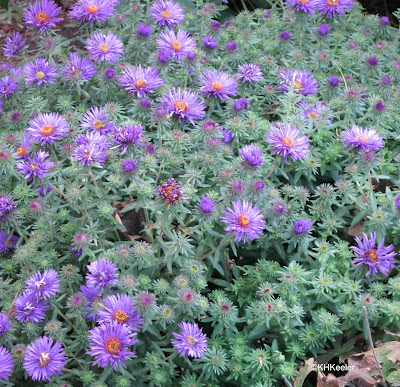Gardening with natives, East Coast style.
On a Road Scholar tour of gardens of the Philadelphia area, we visited Mount Cuba Center. Located in Hockessin, Delaware, the site was the home and gardens of Mr. and Mrs. Lamott du Pont Copeland. Purchased over 70 years ago, the Copelands gradually transformed their home on the top of Mt. Cuba into sweeping vistas, beautiful woods and meadows and luscious gardens. Not only devoted to beauty, the Mt. Cuba Center has become dedicated to promoting gardening and landscaping with native plants.  |
| Mt. Cuba Center |
 |
| View from the back porch |
At one time, the area around Mt. Cuba was eastern deciduous forest, with many different species of trees, for example oak, maple, hickory, chestnut, elm, white pine. A well-developed eastern deciduous forest forms a canopy 60 to 100 feet above the ground, with a second layer of shade-loving trees below them, a third layer of tall shrubs under them and finally an herb layer of plants knee to ankle high along the ground. The area was logged during settlement and then farmed, but the trees have been encouraged to return since then and the paths through the forest revealed stunning forest vistas.
The eastern United States has a rich native flora, thousands of beautiful plants. Some of these are readily available from garden shops, for example the aster below, probably New England aster (Symphyotrichium novae-angliae), but others are harder to find or harder to grow. The Mt. Cuba Center has made growing native plants and encouraging others to do the same a priority.
 |
| New England aster |
Even though September is the beginning of fall, plants were flowering in the herb layer.
 |
| turtle heads, Chelone glabra (acanthus family, Acanthaceae) |
 |
| I can't identify this; please tell me if you know what it is! |
 |
| climbing monkshood, Aconitum hemsleyanum (buttercup family, Ranunculaceae) |
The paths took us to ponds, streams and glades. Though the contours and paths have been shaped by gardeners, the plants have a wild and natural look that was reinvigorating to walk through.
The Center included a meadow where the fall flowers were glorious. I didn't take a distance shot, so I can only show a portrait of spectacular asters and the exuberant combination of cardinal flowers (Lobelia cardinalis, bellflower family, Campanulaceae) and blackeyed susans (Rudbeckia hirta, sunflower family, Asteraceae)! Such a delight!
 |
| a fine pink aster! (Symphyotrichium sp.) |
 |
| another beautiful aster Symphyotrichium (possibly S. laeve) |
 |
| cardinal flowers and blackeyed susans (Lobelia cardinalis and Rudbeckia hirta) |
I found the Mt. Cuba Center a joy and would have happily wandered more.
Comments and corrections welcome.
Note: The asters of the U.S. were once in the genus Aster, but now have been moved to the genus Symphyiotrichium because they are different from Old World asters. Don Lee, botanical punster, asked whether that could be looked as a dis-aster?
Kathy Keeler
More at awanderingbotanist.com
Join me on Facebook: https://www.facebook.com/AWanderingBotanist





No comments:
Post a Comment